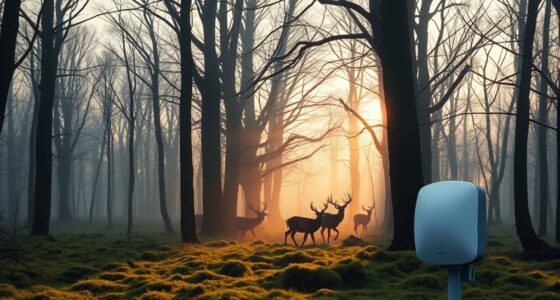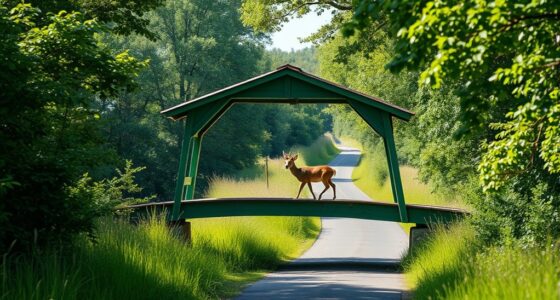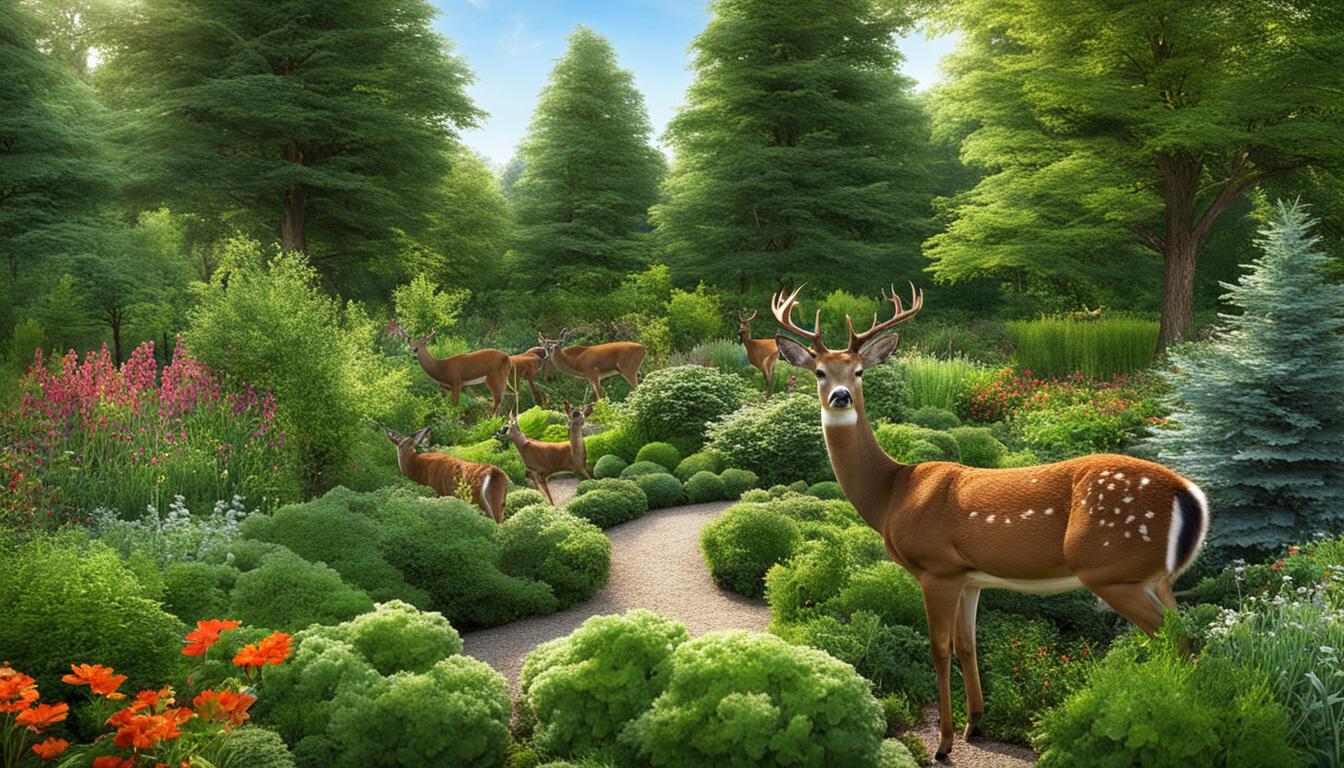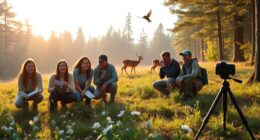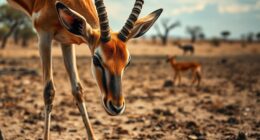Feeding wild deer is generally discouraged because it can disrupt their natural behavior, cause overpopulation, and damage ecosystems. It may lead to health issues for the animals, increase disease risks, and create conflicts with humans. additionally, artificial feeding can weaken their instinct to find natural food and alter migration patterns. To protect wildlife and habitats, it’s best to avoid feeding deer and learn more about responsible wildlife interaction. Keep going to discover essential dos and don’ts.
Key Takeaways
- Avoid feeding wild deer to prevent dependency, habitat degradation, and disruption of natural behaviors.
- Follow local regulations and restrictions on wildlife feeding, especially during hunting seasons.
- If feeding is permitted, use designated areas and appropriate food to minimize health risks.
- Do not over-concentrate deer, as it can lead to disease spread and increased human-wildlife conflicts.
- Support habitat protection and natural foraging opportunities instead of artificial feeding practices.
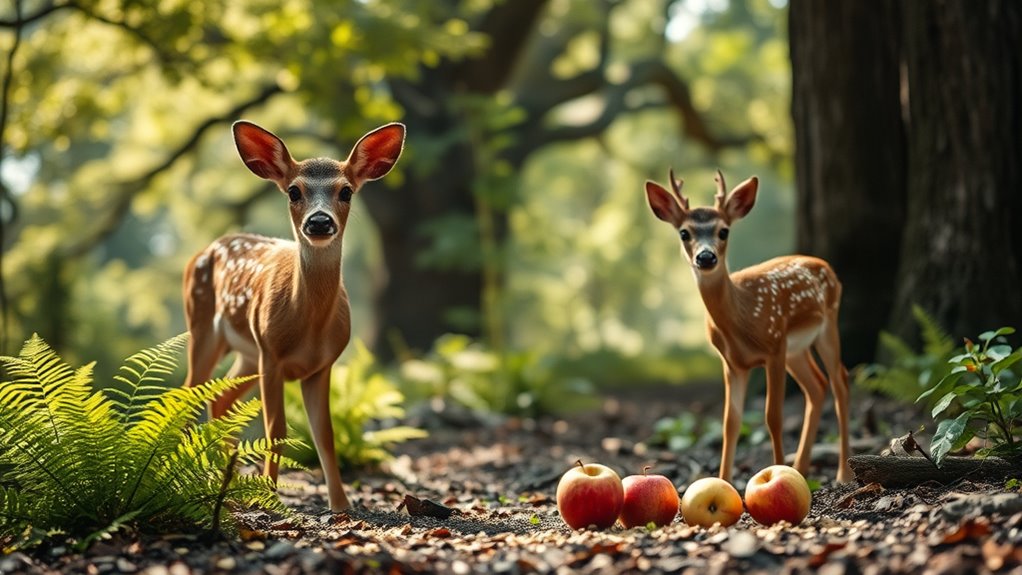
Have you ever wondered whether feeding wild deer is a good idea? It’s a common question among outdoor enthusiasts and nature lovers alike. While it might seem harmless or even helpful, you need to consider the bigger picture, including hunting regulations and wildlife conservation. Feeding deer can unintentionally disrupt their natural behaviors and ecological balance, which is why it’s essential to understand the implications before offering them any food.
Feeding wild deer disrupts their natural behavior and ecological balance; consider regulations and conservation efforts first.
Hunting regulations play a significant role in managing wild deer populations. Many areas have strict rules about feeding wildlife, especially during hunting seasons. These regulations exist to prevent deer from becoming too accustomed to human presence or associating humans with food, which can lead to increased risks for both the animals and people. By ignoring these rules, you could unintentionally support practices that undermine sustainable hunting efforts, which are designed to control deer populations and maintain ecological balance. Additionally, feeding deer outside designated areas may lead to overpopulation in certain regions, causing habitat degradation and increased disease transmission among herds.
From a wildlife conservation perspective, feeding wild deer can do more harm than good. When deer rely on human-provided food, they may lose their natural foraging instincts, making them less capable of finding food on their own. This dependence can weaken their health and immune systems, making them more vulnerable to disease and harsh weather conditions. Moreover, artificially concentrated populations around feeding sites can lead to overgrazing, which damages plant life and disrupts the local ecosystem. Such disruptions threaten not only deer but also other wildlife that share the habitat. Furthermore, habitat degradation caused by overgrazing can diminish biodiversity and harm the overall health of the environment. It is also important to recognize that feeding deer can alter their natural migration patterns, which are critical for maintaining their long-term survival and genetic diversity. Additionally, providing food can sometimes lead to increased human-wildlife conflicts, especially in areas where deer become more accustomed to human presence.
Another important factor to consider is the risk of spreading diseases. When multiple deer gather at feeding stations, the chances of disease transmission increase dramatically. This can have devastating effects on local herds and compromise overall wildlife health. Furthermore, feeding deer can attract predators or lead to increased human-wildlife conflicts, especially when animals become more confident around people in search of food. Additionally, artificial feeding stations can create unnatural congregation points that disturb the natural dispersal of deer across their habitat. Proper management and understanding of wildlife behavior are essential to prevent unintended negative consequences.
Frequently Asked Questions
Can Feeding Deer Spread Diseases to Humans?
Feeding wild deer can indeed pose risks of disease transmission to humans. When you feed deer, you increase close contact, which can spread illnesses like Lyme disease or chronic wasting disease. This impacts human health by elevating exposure to deer-borne pathogens. To protect yourself and wildlife, avoid feeding deer, and maintain a safe distance. Responsible actions help reduce disease risks and support the health of both deer populations and humans.
What Are Legal Restrictions on Feeding Wild Deer?
Legal restrictions limit your lighting, laxity, and liberty when it comes to feeding wild deer. You must understand local feeding regulations, which often prohibit or regulate supplemental feeding to prevent disease spread and ecological disruption. Ignoring these restrictions can lead to fines or environmental harm. Always check with wildlife agencies or local authorities to stay compliant, ensuring your actions support wildlife welfare and adhere to legal and ecological standards.
How Does Feeding Affect Deer Migration Patterns?
Feeding wild deer can disrupt their natural deer migration patterns, causing them to stay in areas with easily accessible food rather than migrating to find better resources. This creates food dependence, which weakens their survival instincts and can lead to overpopulation in certain zones. When you feed deer, you unintentionally interfere with their natural movement, possibly affecting their health and the balance of local ecosystems.
Are There Eco-Friendly Alternatives to Feeding Wild Deer?
Imagine tending a garden where each plant thrives naturally. Instead of feeding wild deer, focus on native plant preservation and habitat restoration, which help deer find food in the wild. This eco-friendly approach supports their natural behaviors and guarantees their environment remains balanced. By nurturing native ecosystems, you create a sustainable landscape where deer can flourish without relying on human intervention, preserving the wilderness for generations to come.
What Signs Indicate Deer Are Becoming Dependent on Human Food?
You’ll notice signs of food dependency in deer when they start relying heavily on human-provided food, often ignoring natural forage. They may gather around feeding sites even when food isn’t offered, and their health decline becomes apparent with weight loss or weakened immune systems. If deer appear less interested in natural foods and show signs of malnutrition or illness, it indicates their food dependency is impacting their health.
Conclusion
Remember, feeding wild deer isn’t just about kindness; it can impact their health and the ecosystem. Did you know that over 70% of deer in some areas have been found to carry ticks that can transmit Lyme disease? By avoiding feeding, you help prevent dependency and protect both the deer and your community. So, enjoy watching them from a distance and let nature take its course—it’s the best way to keep everyone safe and healthy.



